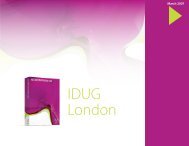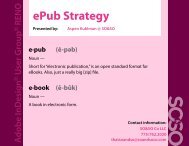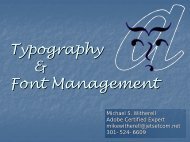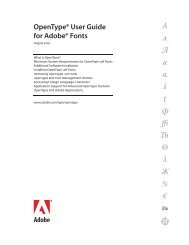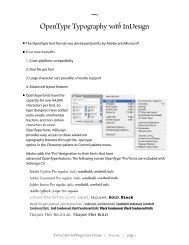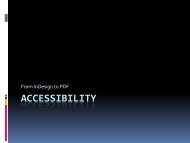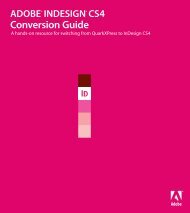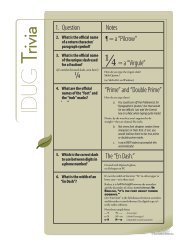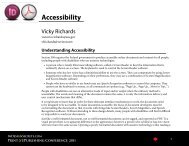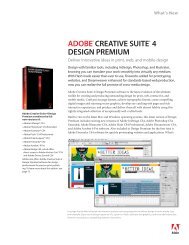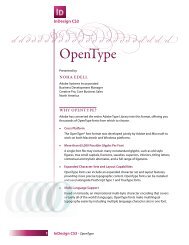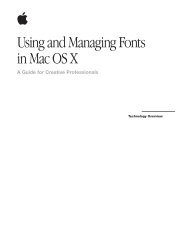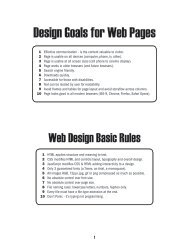Quark to InDesignCS3 Conversion Guide - InDesign User Group
Quark to InDesignCS3 Conversion Guide - InDesign User Group
Quark to InDesignCS3 Conversion Guide - InDesign User Group
Create successful ePaper yourself
Turn your PDF publications into a flip-book with our unique Google optimized e-Paper software.
what are object styles in <strong>InDesign</strong>?<br />
Object styles work like paragraph<br />
and character styles. An object style<br />
is a saved set of object-level attributes<br />
that you can apply repeatedly. The<br />
basic attributes available for object<br />
styles are Fill, Stroke, Stroke & Corner<br />
Options, Paragraph Styles, Text<br />
Frame General Options, Text Frame<br />
Baseline Options, S<strong>to</strong>ry Options,<br />
Text Wrap & Other, Anchored Object<br />
Options, and Frame Fitting Options.<br />
You can include a variety of<br />
Pho<strong>to</strong>shop effects, such as Drop<br />
Shadow, Bevel And Emboss, and<br />
Gradient Feather, in an object style,<br />
and you also have the option <strong>to</strong><br />
assign any effect <strong>to</strong> an entire object<br />
or separately <strong>to</strong> the object’s stroke,<br />
fill, or text.<br />
Object styles are great time-savers<br />
and help ensure consistency if you<br />
often use similar-looking objects. For<br />
example, if you create publications<br />
that include sidebars within stroked<br />
text frames, you could set up an<br />
object style that specifies the width,<br />
style, and color of the stroke, as well<br />
as text insets. Each time you need a<br />
sidebar frame, you simply create a<br />
rectangular object, and then apply<br />
the object style.<br />
To create an object style, choose<br />
Window > Object Styles, and then<br />
do one of the following:<br />
58 Adobe <strong>InDesign</strong> CS3 | <strong>Conversion</strong> guide<br />
• Design an object with all of the formatting<br />
you want <strong>to</strong> include in an<br />
object style. For example, you could<br />
apply a stroke and corner effect,<br />
creative effects (such as blending<br />
and opacity), text frame attributes<br />
(columns, gutters, and text insets),<br />
and text wrap settings. Then, with<br />
that object selected, choose New<br />
Object Style from the Object Styles<br />
panel menu, specify a name, adjust<br />
any settings, and click OK.<br />
• Set up an object style by choosing<br />
New Object Style from the Object<br />
Styles panel menu with no object<br />
selected. Specify the formatting<br />
attributes you want, and then<br />
click OK.<br />
In addition <strong>to</strong> creating object styles,<br />
you can set default styles for the drawing<br />
<strong>to</strong>ols. To set the default style for<br />
new text frames, drag the text frame<br />
icon (the square box with<br />
a “T” within) in the Object<br />
Styles panel list <strong>to</strong> the object style you<br />
want <strong>to</strong> use. To set the default style for<br />
new graphics frames created with the<br />
Rectangle <strong>to</strong>ol, the Ellipse <strong>to</strong>ol, or the<br />
Polygon <strong>to</strong>ol, drag the graphics frame<br />
icon (the empty square) <strong>to</strong> the object<br />
style you want <strong>to</strong> use.<br />
The options available for object<br />
styles are similar <strong>to</strong> those available<br />
for character and paragraph<br />
styles. For example, if you modify<br />
an object <strong>to</strong> which an object style is<br />
applied, you can quickly update the<br />
style—and all other objects the style<br />
is applied <strong>to</strong>—by choosing Redefine<br />
Object Style from the Object<br />
Styles panel menu. You can break the<br />
link between a selected object and<br />
an object style by choosing Break<br />
Link To Style, and you can choose<br />
Load Object Styles <strong>to</strong> import object<br />
styles from other <strong>InDesign</strong> documents.<br />
When you load styles, you<br />
can choose the styles you want <strong>to</strong><br />
import and specify how <strong>to</strong> handle<br />
conflicting style names, just like with<br />
paragraph and character styles.<br />
what are table styles and cell styles<br />
in <strong>InDesign</strong>?<br />
Like character styles, paragraph<br />
styles, and object styles, table styles<br />
and cell styles—new in <strong>InDesign</strong><br />
CS3—let you format tables, and<br />
cells or groups of cells within tables,<br />
quickly and consistently. Instead<br />
of manually formatting individual<br />
cells and tables, you can create a<br />
table style, s<strong>to</strong>re it in the Table Styles<br />
panel (Window > Type & Tables ><br />
Table Styles), and instantly apply it<br />
<strong>to</strong> any table, including a spreadsheet<br />
from Microsoft Excel or a table from<br />
Microsoft Word. Within a table style,<br />
you can also apply a cell style <strong>to</strong> a<br />
specific region of cells; for example,<br />
you can apply unique formatting <strong>to</strong><br />
a table’s header, footer, and body. For<br />
information about creating table and<br />
cell styles, see page 67.




